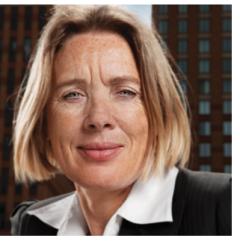ANGELIEN KEMNA LIKES TO KEEP THINGS SIMPLE. OR AT least as simple as she can, considering it’s her job to oversee €300 billion ($376 billion) in pension assets. In November 2009, after becoming CIO at APG Asset Management, which runs the biggest Dutch pension fund, Kemna wanted to bring her scattered executive team together on a single floor, but she faced a shortage of offices. Her solution? She gave her corner office on the 15th floor of APG’s Amsterdam headquarters to a colleague and moved into a conference room. Kemna works at one end of the long, blond wooden conference table and keeps her personal effects in cabinets at the back of the room. If her staff needs the space for a meeting, the CIO decamps to the nearest empty office and gets on with her work.
With her no-nonsense style, Kemna has been simplifying much more than office arrangements at APG and its predominant fund, Stichting Pensioenfonds ABP, the €261 billion plan for Dutch civil servants and teachers that’s the second-largest pension fund in the world. In the 15 or so years before Kemna’s arrival, her predecessors had transformed the outfit from a stodgy manager of Dutch bonds and real estate into one of Europe’s most diversified, cutting-edge investors. CIOs Jean Frijns and later Roderick Munsters took advantage of a liberalization of Dutch pension rules and embraced the so-called Yale model, investing heavily in everything from international stocks and bonds to hedge funds and private equity. Today, APG has nearly 30 percent of its funds in alternative investments, including such exotica as Amsterdam-based hedge fund seeder IMQubator and a €1.5 billion opportunity fund that holds music rights, catastrophe bonds and pharmaceuticals royalties.

Compounding the impact of those losses, a change in Dutch regulations aimed at shoring up pension solvency required funds to adopt a much lower interest rate to discount their future liabilities. The combined effect was dramatic. ABP went from being one of the best-funded major pension funds in the world, with assets worth 140 percent of liabilities at the end of 2007, to being an underfunded plan with a coverage ratio of just 89.6 percent 12 months later. The Dutch central bank, which regulates pension funds, ordered a five-year recovery plan that forced ABP to cut retirees’ cost-of-living increases and increase employees’ contributions. Even so, ABP remains underfunded and is likely to have to impose new benefit cuts next April.
The dramatic decline in what has long been considered Europe’s leading pension fund, and pension system, has caused an uproar in the Netherlands and triggered widespread calls for pension managers to rein in risk. “You have a public that’s angry,” says Scott Evans, a member of ABP’s external investment committee, who earlier this year stepped down as president of asset management at TIAA-CREF in New York. “When the market moves suddenly in the Netherlands, it has a much more immediate impact on pension premiums and benefits than we experience in the United States. This is healthy for the long-term viability of the system but difficult for current participants.”
Pension regulators, trustees and pensioners were demanding change from the moment Kemna arrived at APG. “It required a drastic shift of policy, a harsh shift,” she tells Institutional Investor.
With a Ph.D. in quantitative economics and two decades of experience in senior roles at Dutch mutual fund manager Robeco and at ING Group, Kemna was no stranger to complex portfolio management strategies. Her challenge was to strike a balance between maintaining a diverse portfolio suitable for ABP’s long-term liabilities and responding to the clamor for scaling back investment risk. In her first week on the job, the new CIO began to draw up a plan to root out any securities, strategies and investment managers that were taking on too much risk for the amount of return they were generating and causing too much volatility. To get her staff to rally round these changes, Kemna coined a theme for the new regime: “Controlled simplicity” would become the order of the day.
Over the next two years, Kemna and her team would take a line-by-line inventory of the way APG was investing across its 14 different asset classes, ranging from emerging-markets equities to hedge funds. They kept all of those classes — and even added a new one, alternative inflation — but made sweeping changes to simplify operations and reduce risk. In alternatives, for instance, where APG manages €80 billion, Kemna ditched an in-house global tactical asset allocation team because it traded so many exotic derivatives, which she believed exposed APG’s funds unnecessarily to potential market turbulence. For similar reasons, she also fired two external managers in the group’s €3.4 billion GTAA portfolio. With the same risk-reducing strategy in mind, she and her team weeded through APG’s €79 billion developed-markets equity portfolio, removing external managers of so-called 130-30 strategies, a kind of hedge-fund-lite product that seeks to generate higher returns with a mix of long and short positions. “We said good-bye to external managers who couldn’t deliver simple strategies or align with our interests,” Kemna explains.
Digging deeper, the CIO and her team adopted a new, “smart beta” approach and scrubbed every single portfolio, except for alternatives, to eliminate benchmark flaws. In APG’s €40.5 billion core Treasuries portfolio, for instance, managers ditched government bonds from heavily indebted euro zone countries. “If you add a strategy that adds too much complexity and operational risk, then you’re not doing the right thing for your client,” says Kemna.
It took more than a new approach to change course at APG; it took new people who shared Kemna’s vision of a lower-risk fiduciary manager. In her first six months on the job, the CIO would replace four of her five fellow executive board members, leaving only Paul Spijkers, who heads APG’s New York office and its alternatives portfolio. “Whenever you want to change a culture, you need to change a few key positions, and it starts at the top,” says Kemna.
The transformation has been dramatic, says Ronald Wuijster, former head of strategic portfolio management, whom Kemna made chief client officer and an executive board member. “Since Angelien we’re less into innovation and more into making it as simple as possible,” he says. “Risk management is our primary job.”
Complicating Kemna’s task is APG’s relatively new status as a fiduciary manager. A 2007 Dutch pension law, aimed at strengthening pensions following losses from the dot-com bust at the start of the decade, effectively forced pension funds to turn over their asset management to independent firms. About 18 months before Kemna arrived, ABP’s board voted to spin out its money management and administration functions into a newly created firm, APG. The change has added a new layer of bureaucracy, as ABP created a bestuursbureau, or secretariat, to help the pension trustees oversee APG’s work. The new arrangement also demands greater accountability of APG, forcing Kemna and her team to explain and justify their strategy to ABP trustees. But with new demands come new opportunities: APG has used its independence to win the management business of five other pension schemes and merge with Cordares, the €35 billion manager of the Netherlands’ building and construction sector pension fund.
Kemna’s challenges notwithstanding, many pension managers would love to be in her position. The Dutch pension system has earned a reputation as arguably the best in the world because of its comprehensiveness and robust funding. Participation is compulsory for most Dutch workers, with more than 90 percent of the labor force enrolled in a pension plan. In a world where most pension contributions are in the single digits, Dutch employees squirrel away an almost unheard-of 20 percent or more of their annual salaries, with employers kicking in 70 percent and employees the remainder. A strong sense of intergenerational risk-sharing helps ensure balance during times of economic stress, when retirees may forgo cost-of-living increases while participants and employers boost their contributions. Last, it helps to have pension assets managed in large pools that ensure economies of scale, leaving pensioners with more euros in their pockets.
“The notion of mutual support across society is deeper than in the U.S.,” notes Leo de Bever, CEO and CIO of Alberta Investment Management Corp. in Edmonton, Canada. De Bever serves on ABP’s external investment committee. “Given that everyone in the Netherlands has some pension, there is more support for making it sustainable.”
And how. Dutch pension fund assets amount to 134 percent of the country’s gross domestic product as of 2008, more than those of any other member of the Organization for Economic Cooperation and Development, according to OECD figures. By contrast, Australia’s pension assets stood at 91 percent of GDP and the U.S. was at 72.6 percent. “If you count that in, we’re part of the richest country in the world,” says Guus Warringa, APG Asset Management’s chief legal counsel. The Netherlands’ pension system ranks first among 16 countries because of its strong adequacy, sustainability and integrity, according to the Melbourne Mercer Global Pension Index, a joint study conducted last year by the Australian Center for Financial Studies and consulting firm Mercer. The U.S. holds tenth place.
Yet even the stalwart Dutch have found it difficult to cope with two financial crises in one decade. The first blow came from the dot-com bust and resulting drop in equity markets, which caused the average pension fund to suffer losses of about 8 percent in 2002. Two years later trustees of all Dutch plans decided to end early-retirement benefits after the government withdrew its share of funding for those benefits. The changes were a rude shock for Dutch workers and retirees. In October 2004 hundreds of thousands of people thronged central Amsterdam’s Museumplein, surrounded by the priceless collections of van Goghs, Rembrandts and Vermeers that represent the Netherlands’ rich cultural patrimony, to protest the threat to their standard of living.
The public pressure prompted lengthy debate, and in 2007 Parliament passed a new pensions act in a bid to shore up the system’s solvency and strengthen the transparency and accountability of pension management. The act set a minimum asset-to-liability ratio of 105 percent and mandated corrective action for any plan falling below that threshold. The law also changed the rate for discounting future liabilities from a fixed 4 percent to a rate calculated monthly by the central bank based on interbank swap rates. Dutch officials reasoned that it was more prudent to use a market rate, which should better reflect what funds could expect to earn. But when interest rates plunged following the 2008 financial crisis, pension trustees saw their funding ratios plunge in tandem. Almost overnight ABP went from being generously overfunded to seriously stretched, prompting the central bank to order a five-year recovery plan.
Although there have been no major public demonstrations of late, the Dutch media are filled with debate over how pensions should be structured in an era when low interest rates and longer life spans threaten pension plan solvency. The long-revered concept of solidarity has begun to fray as young people fret that the money won’t be there for them and as their elders see their pension checks trimmed. One union blasted pension funds as “casinos” that were gambling with workers’ money. “It was a disaster,” explains Gerard Riemen, director of the Dutch Pensioenfederatie, an umbrella organization for 400 pension funds. Riemen helped write the 2007 legislation as an official at the Ministry of Social Affairs and Employment. “It was a real wake-up call,” he says. “We have to think about revising the whole pension contract.”
At ABP funding pressure persists even though the fund achieved positive returns of 20 percent in 2009, 13.5 percent in 2010 and 3.3 percent in last year’s difficult market conditions. The discount rate, calculated by the central bank, stood at about 2.6 percent last month, making it difficult for ABP to reach the 105 percent coverage bogie. At the end of April, the funding ratio stood at 94 percent. Barring a dramatic improvement, pensioners are facing a likely 0.5 percent reduction in their monthly checks starting next year.
It’s that prospect that’s keeping the heat on Kemna. “Close to one third of our country depends on whether we’re doing a good job,” she says. “The professional challenge is immense.”
“ABP WAS BORN ON THE SEA,” DICK Sluimers likes to say. A former chairman of the Algemeen Burgerlijk Pensioenfonds board and CEO of APG since its 2008 inception, he is referring to the ABP Act, signed into law on the SS Batavier V steamship by Queen Wilhelmina in 1922. For decades the pension fund took contributions, starting at 10 percent of salaries and rising to 16 percent in 1947, and invested them conservatively in Dutch bonds and real estate.
In the 1990s the government revised pension law to require funds to be organized as stichtings, or foundations, run equally by representatives of employers and employees. The new rules allowed funds to invest in a wider range of assets, including international stocks and bonds, private equity and hedge funds, and to adjust cost-of-living raises as conditions and returns warranted.
In 1996 the renamed Stichting Pensioenfonds ABP took advantage of the new freedoms and embarked on a diversification of its portfolio under then-CIO Frijns. Crucially, Frijns and his team decided to manage as much of the portfolio in-house as possible rather than hiring external managers. “We decided we didn’t want to outsource everything, because it was too costly,” says Spijkers, who joined ABP’s legal department after graduating from law school in 1984. So Spijkers and three colleagues packed up and moved to New York in August 1998 to open a U.S. office and build up ABP’s investments in U.S. real estate, bonds and hedge funds. Today, Spijkers is president and CEO of APG Asset Management U.S., and oversees a 110-strong team, only seven of whom are Dutch. Overall, Kemna and an investment staff of 200 manage 80 percent of APG’s assets in-house.
In 2002, Frijns launched a fund-of-hedge-funds portfolio in Amsterdam, but he soon realized it would be more cost-effective to build a team in the U.S. He hired Tom Dunn and Ira Handler, then co-heads of fixed income at Lazard Asset Management, to run the portfolio out of New York. In 2006 they began operating autonomously as New Holland Capital, in the Chrysler Building, near APG’s Third Avenue office. APG figured that giving the team greater independence would foster stability and avoid attrition, Spijkers says. “There are a lot of people out there who invest in hedge funds and don’t know what they’re doing,” he notes. Today, New Holland, working solely for APG, has 26 employees overseeing 60 different hedge fund investments worth a total of €11.7 billion, or 4 percent of APG’s overall portfolio.
When Frijns stepped down in 2005, ABP tapped Munsters, a rising star in Dutch pension management, as his replacement. Munsters, then 42, had served seven years as CIO at PGGM, the Netherlands’ second-largest pension fund, expanding aggressively into alternatives and making the fund one of Europe’s largest private equity investors. Munsters brought a similar approach to ABP, setting out to increase the innovation, and complexity, of the giant fund. He brought in a former head of research and strategy at PGGM, Gerlof de Vrij, to head up the new, €2.3 billion, internally managed global tactical allocation portfolio and hired Wuijster, former head of investment research at Robeco, as ABP’s new chief of strategy and research. In a 2007 profile Munsters told II, “We can and should be at the forefront of innovation because of our in-house capabilities, size, long-term perspective and high risk tolerance.”
In 2007 the new Dutch pension law overhauled governance rules, requiring pension boards to either jettison ancillary businesses such as insurance, which funds like ABP had expanded into, or turn asset management over to outside entities. ABP’s board, like PGGM’s, decided to spin off its investment management and fund administration operations into a 100 percent-owned subsidiary dubbed APG, with Munsters continuing as CIO.
Some doubted the wisdom of the separation. “I warned them personal experience had taught me it would introduce organizational complexity,” recalls ABP external investment committee member de Bever. “Buying and selling assets is easy in a single-client environment. With multiple clients there is an obligation to demonstrate that transactions on behalf of one client treat all others fairly.” Nonetheless, the breakup went ahead. Olaf Sleijpen, director of pension supervision at De Nederlandsche Bank, the central bank, acknowledges that the governance changes make it harder for pension trustees “to be in control.” But he points out, “You create a much clearer business relationship between pension service providers and the board.”
It would be hard to imagine a more challenging time to launch a new fund management entity. By March 2009, just 13 months after its launch, APG’s portfolio had plunged 20.2 percent, losing €44 billion. “It was a mind-boggling number,” says Munsters, who worked hard to keep up his staff’s morale while meeting regularly with ABP’s bestuursbureau to keep them informed of their funds’ performance. He also negotiated a merger with Cordares, the building and construction industry pension manager, in September 2008. In early 2009, Munsters was offered the role of CEO of Robeco, the biggest Dutch mutual fund manager. APG would need a new CIO to lead a turnaround.
ANGELIEN KEMNA’S ROOTS WERE formed in the soil of Dutch farmland. Her parents were both born to farmers in Twente, a region in the eastern Netherlands where agriculture is still the No. 1 industry. After World War II, Kemna’s father left the family farm and, with his young bride, set out to find work as a bookkeeper, while taking night classes to earn an accounting certificate. Kemna, born in 1957, the second of four children, grew up in modest circumstances. The family moved each time her father changed jobs, until he obtained a management role in a company that manufactured fishing nets and rope; Kemna would help out with accounts and administration in the summers.
After scoring well on the high school placement exam given to 12-year-olds, Kemna was accepted at a gymnasium, the highest level of secondary education, near her home in the southwestern Netherlands. She discovered a flair for leadership when she organized a girls’ basketball team at the small, monk-run school and coached them to win four regional trophies. Upon graduation Kemna enrolled at Erasmus University Rotterdam, where she studied econometrics and met her husband-to-be, Aart van Beuzekom, who shared the same major. After eight years together they married in 1985. Three days after their wedding, Kemna left for the U.S. — alone — to do a six-month stint as a visiting scholar at the Sloan School of Management at the Massachusetts Institute of Technology. There she took a class in derivatives with Robert Merton, who would help her with her Ph.D. thesis and later share the Nobel Prize in economics for his work on the Black-Scholes formula for pricing stock options.
Returning home, Kemna earned her Ph.D. in finance at Erasmus in 1988, writing her thesis on the use of financial options in investing. She and van Beuzekom began investing on the European options exchange and started a vacation fund with their gains. “If we did well, we went to India, the U.S. and Africa,” recalls Kemna. When it came time to plan a family, the couple agreed that each would take a 50 percent share of parenting duties. “You had day care, which enabled me to become an associate professor,” explains Kemna, who taught finance at Erasmus from 1988 to 1991, then took a part-time teaching stint at Maastricht University from 1993 to 1999. Her husband started his own software company, Ortec, in 1981, giving him the flexibility to help raise their son and daughter. That turned out to be a good choice. Today, Ortec provides everything from transportation logistics software to asset-liability studies to some 1,350 customers in more than 60 countries.
On the strength of her reputation in the application of derivatives theory, Kemna was recruited into the world of asset management in 1992 by Rotterdam-based Robeco. She started as head of quantitative research, leading a group of Ph.D. candidates. She then switched into portfolio management — “from making the models to investing the money,” as she puts it — heading a team of 50 in global equity management and helping to bring quant techniques into the mainstream at Robeco. By 2001 she was director of investments and account management.
Then ING came knocking, hiring Kemna as global CIO of the bank’s asset management division. She arrived just as the fallout from the burst dot-com bubble was hammering equity markets and almost immediately had to begin cutting costs and rationalizing operations. A year later ING split its global asset management business into three regions. Kemna requested and won the jobs of CIO and CEO of the new European region. She would no longer just crunch market data. Now she had to learn how to oversee investment technology, human resources and marketing, among other things — an experience that would be daunting but invaluable. “I had demanded that job, but I’m not sure I knew what I had asked for,” she says.
As it recovered from the 2002 downturn, ING began a period of rapid growth and change. Over six years Kemna, who shed the CIO role in 2004, reported to four different executive board members.
In April 2007, overseeing €152 billion in assets across 14 countries, Kemna announced that she would leave ING that July. Increasingly, she had felt that asset management was not a good fit for a former academic who wanted to do work that would benefit others. “There was nothing more that excited me,” she explains. “I was fed up with the general culture in the financial industry. I had just had it.” Her timing was impeccable: ING shares were trading at €35 when she exercised her stock options; they would touch €2.30 in March 2009 and are still below €5.60 a share. “It was a lucky coincidence,” says Kemna.
Over the next two years, Kemna would split her time between the Netherlands, where she taught econometrics part-time at Erasmus, and Atlanta, where she and her husband had bought a house to be near the headquarters of Ortec’s largest corporate client. She also served on the Authority for the Financial Markets, the Dutch securities and investments regulator, and took on a few nonexecutive directorships, including one at Yellow&Blue Investment Management, a Dutch renewable-energy venture capital company.
It would be two years before a recruiter called Kemna about the CIO position at APG. “It was the first phone call where I said I wanted to look at the job,” she recalls. “I thought it was a pretty good job, managing the pensions of 33 percent of the country’s inhabitants.” Having spent a good part of the financial crisis in the U.S., she had seen firsthand what happened to older Americans who lost their pensions and life savings. “It can happen very easily, as we’ve seen in the U.S. and also the U.K.,” she says. “I wanted to make sure the Dutch system was in good shape.”
She had her work cut out for her. By the time she started at APG in November 2009, more than half of the country’s 650 pension funds, including ABP, had been forced to file recovery plans with the central bank. They would have three years to raise their funding ratios above the 105 percent minimum, or they would be forced to cut pensioners’ benefits. The challenge was compounded by the drop in interest rates, which weighed on those funding ratios. Pension trustees and rank-and-file employees angered by fund losses were calling for change. “People were saying, ‘Put the money in the bank so it’s safe,’ ” says the pension federation’s Riemen.
As if those pressures weren’t enough, Kemna was taking over from Munsters, an icon in the Dutch pension world even after the market crash. Shifting from a culture that championed innovation to the more sober approach of a fiduciary manager wouldn’t be easy. “If you run an organization as if you have no client and it’s your money, the accountability is different than if you’re a multiclient organization,” Kemna says of the old ABP. “The staff thought they had more leeway to invest as they saw fit.”
Kemna proceeded to make wholesale changes to APG’s top ranks, replacing not only most of the executive board but also the CIOs of the group’s two major portfolios, growth and income (which Kemna would change to listed and alternative), and the heads of trading, convertible bonds and information technology. She also encouraged her top executives to change their own personnel wherever necessary. “The hardest period for me was the first three to six months,” says Kemna. “It was perhaps the loneliest period in my life.”
The CIO believed she could find qualified staff who, like herself, came from profit-oriented banks and money managers but were willing to work for less money at an institution built to safeguard the retirement savings of ordinary workers. “You do it for your teacher in grammar school,” Kemna explains. “I’ll be damned if a bank profits from my grammar school teacher. I can attract people with much lower salaries who want to achieve this.”
Kemna made several internal promotions to the executive board, including chief client officer Wuijster and legal counsel Warringa.
As for the actual business of asset management, Kemna never questioned Munsters’ broad allocation strategy. In fact, she retained as much as possible — keeping the alternatives weighting intact, for example, despite the clamor from pension trustees and plan members to drastically scale back risk. “It’s important not to give in to outside pressure,” she says. “We have to convince our participants that we’re long-term investors.”
In seeking to reduce risk, one of the first areas Kemna and her team focused on was the global tactical asset allocation team established by Munsters. Kemna wanted to simplify the fund by eliminating its costly and complex use of exotic derivatives; GTAA head de Vrij left in March to open a Dutch office for Blenheim Capital Management, a New Jersey–based hedge fund firm. APG also dismissed two external GTAA managers. The portfolio is now run by six external global macro hedge fund firms that were willing to jettison their use of exotic derivatives. “I wanted a simpler global tactical asset allocation product,” explains Kemna. She believes GTAA can produce good risk-adjusted returns by tactically moving cash from one asset class to another using futures or by trading the underlying equities and bonds.
In some cases, as with emerging-markets debt, APG found it wasn’t cost-effective to build a team in-house. In other areas, such as Japanese large-cap equities, Kemna decided not to hire an external manager because it’s so difficult to generate alpha in that strategy. Instead, APG runs those portfolios using a new, “smart beta” approach in which it tailors portfolios to client needs by eliminating undesirable index constituents.
Nowhere has this strategy come into play as heavily as in fixed income, which represents 40 percent of APG’s holdings. With Europe’s debt crisis continuing to worsen, APG has eliminated the bonds of highly indebted euro zone countries from its core Treasuries strategy, retaining only German, Dutch and French paper. APG has stripped convertible bonds from its fixed-income portfolios, seeing them as a mix of European midcap equities and high-yield bonds (both of which APG already owns) but inherently more difficult to value.
“We don’t take the benchmark for granted,” says Céline van Asselt, chief finance and risk management officer. “In the past the benchmark was the guiding light. Today we say, ‘Be critical.’ ”
APG has also used the smart-beta approach to launch a minimum variance strategy in April. The €7 billion strategy targets global equities with low volatility and sits inside APG’s €79 billion developed-markets equity portfolio, which makes up more than a quarter of the group’s total. According to Wuijster, the strategy can achieve the same returns as a classic equity strategy, with 25 percent less risk.
A fourth example of smart beta is APG’s policy of not automatically rolling over the commodity exposure at month’s end, as dictated by the Goldman Sachs Commodity Index. The €11.7 billion portfolio represents a little less than 4 percent of the total; it achieved a 15.8 percent return in 2010, followed by a 6.1 percent return in 2011.
Kemna and her team have found other ways to reduce risk in the developed-markets equity portfolio. The group instructed its external 130-30 managers to shift to a long-only stance and eliminate complex derivative overlays. The managers’ response? “They said they had enough alpha left and admitted the derivatives were not so important,” says Ronald van Dijk, whom Kemna hired as head of equities in August 2011 after 14 years at ING. The change had another benefit: It has reduced fees on the funds involved by 30 percent over the past year.
Not surprisingly given Kemna’s background, APG has increased the share of quantitative strategies in the developed-markets equity portfolio, to 60 percent from 50 percent. An additional 30 percent is managed in fundamental strategies, while 10 percent has been allocated to a new “focused,” or concentrated, portfolio that invests in fewer companies, with a longer time horizon and without adhering to the MSCI World Index benchmark.
Not all portfolios have been overhauled. The roughly €80 billion alternatives portfolio has remained essentially intact under the command of Spijkers. But he continues to search for new, albeit simplified, instruments to diversify the 70 percent of the portfolio that is in traditional equities and bonds. He recently added a new strategy, dubbed alternative inflation — basically a bond portfolio — to hedge against unexpected moves in inflation. In the absence of Dutch inflation-linked bonds, Spijkers identified a large segment of nongovernment bonds that have inflation-linked income streams: utility companies.
Portfolio and staff changes are only part of Kemna’s strategy for improving the delivery of investment services and pension benefits to APG’s clients and their millions of participants. Increasing scrutiny from oversight parties is placing continuous demands on the client management and communications divisions. Kemna has been lobbying officials at the central bank and Ministry of Finance to go back to a 4 percent discount rate, which would return her pension client to fully funded status. For his part, pension supervisor Sleijpen is not swayed. “If central banks did not keep interest rates low,” he says, “the value of pension funds would be much lower today.”
With her new staff in place to handle APG’s many asset management programs and external demands, Kemna is closer to achieving the goal that brought her back to the asset management world: the continued success of the Dutch pension system. She advised the U.K. government as it was setting up its new defined contribution scheme, the National Employment Savings Trust (NEST), which has created a large pool of individual retirement assets, while acknowledging that the new program doesn’t approach the level of benefits in the Netherlands. While attending a pension conference in the U.K. last fall, Kemna says, “I was shocked to see how far they’ve moved from defined benefits to savings. People don’t save because it’s voluntary there.”
That’s not a problem in the Netherlands, given the pension system’s strong funding. But Kemna and her team need to generate consistently good returns to provide security for ABP’s beneficiaries. Simple? Hardly, but Kemna is more than up for the challenge. • •






